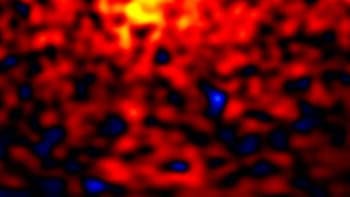A new type of dark matter made up of collections of atoms that form balls up to 20 centimetres in size has been predicted by two theorists in Scotland and Denmark. The balls, which could weigh about 1011 kilograms each, would be hard to detect but may exist inside heavy stars. The physicists think the balls might eat up the star and release enough energy to make it explode as a supernova. They believe there may be, on average, one dark-matter ball for a volume of space about the size of our solar system (Phys. Rev. Lett. 95 231301).
Dark matter was originally proposed to explain why galaxies rotate much faster than can be explained by the amount of visible matter they contain. This mysterious form of matter does not emit or absorb electromagnetic radiation — hence the name “dark” — and can only be detected by its gravitational influence on ordinary matter. According to the standard model of cosmology, the universe is thought to contain about 5% of ordinary matter, 25% of dark matter and 70% of dark energy. The nature of this dark matter and energy is the biggest mystery in cosmology today.
Unlike some other recent theories, the new model for dark matter, which has been proposed by Colin Froggatt of Glasgow University and Holger Nielsen of the the Niels Bohr Institute in Copenhagen, does not require any new fundamental particles or interactions beyond the Standard Model of particle physics. The model also predicts a ratio of dark matter to ordinary matter that agrees with the value obtained by NASA’s WMAP satellite in 2003. It does, however, assume the existence of an “alternative vacuum” that has the same energy density — or “cosmological constant” — as our own ordinary vacuum.
Froggatt and Nielsen calculate that the two different types of vacuum separated out into different regions of space quite early in the history of the universe by “domain walls” that formed at the high temperatures present at this time. Roughly one second after the Big Bang, the researchers say, these walls formed balls that encapsulated matter inside pieces of the alternative vacuum. All nucleons might have been captured this way, leading to the formation of the first light nuclei, such as helium, as the balls rapidly contracted.
This contraction continued until the helium nuclei fused together to form heavier nuclei and the energy released in the subsequent chain reactions expelled the nucleons from the balls say the researchers. According to the new model, one sixth of the nucleons were freed this way, entering the ordinary vacuum and becoming normal matter. The rest of the nucleons remained trapped as dark matter inside the balls of the alternative vacuum.
The team believes that some of the balls might have collected inside heavy stars. At sufficiently high temperatures and densities, they could have started consuming the star, so releasing enough energy to make it explode in a supernova. The balls themselves could even implode and therefore provide a way to produce ultra-high energy cosmic rays from seemingly empty places in the universe. The researchers also say that their theory might explain why the amount of lithium in the universe is 2 to 3 times less than is predicted by the standard Big Bang nucleosynthesis model.



